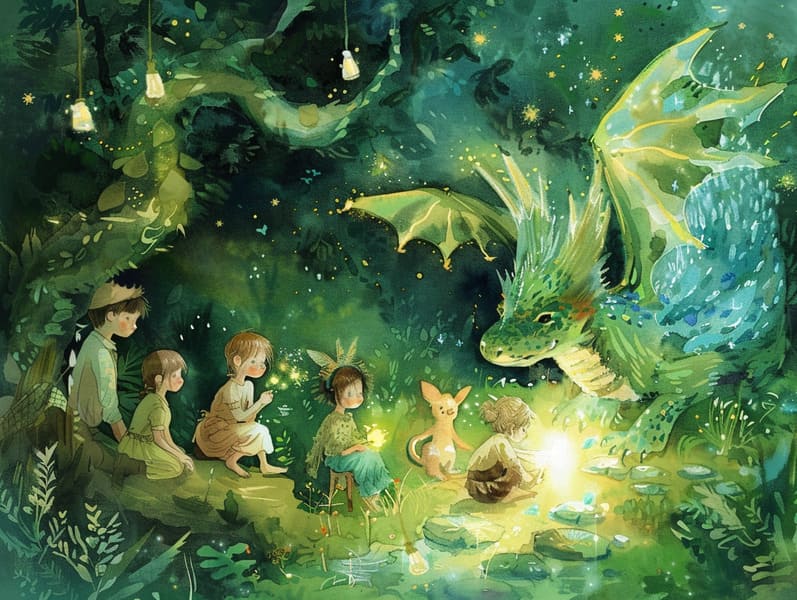A Brief History of Online Fairy Tales and the Continued Radiance.
A Brief History of Online Fairy Tales and the Continued Radiance.
Blog Article

Legendary fairy tales have ancient roots. These tales have been narrated from one generation to the next millennia before they were ever recorded. They sprang from a variety of societies, including African traditions. They were initially passed along among adults, often carrying themes and messages related to the societal norms and beliefs of the time.
The Grimm brothers, Jacob and Wilhelm, were among the first to collect and release many of these beloved tales. Their volume, "Grimm's Children's Stories," included narratives like "Cinder Maid," "The Story of Hansel and Gretel," and "Schneewittchen," which have since become hallmarks in the world of traditional fairy tales. Similarly, Hans Andersen's whimsical fairy tales, such as "The Mermaid's Tale," and "The Duckling that Could," have gained the love worldwide, cementing their place in the pantheon of classic fairy tales.
Though they are centuries old, classic fairy tales remain as pertinent as ever, especially as children's night stories. These charming stories are now available in various formats, including beautifully illustrated books, charming animations, and online fairy tales.
Their unwavering allure can be ascribed to several magical reasons:
Valuable Lessons: Classic fairy tales often share important moral lessons. Fairy tales like "The Story of the Boy Who Cried Wolf" teach the benefit of truthfulness, while "The Race of the Tortoise and the Hare" underline the qualities of resolve and modesty. These narratives offer young readers clear distinctions between truth and falsehood, developing their moral compass in a kind yet lasting way.
Sympathy and Perception: Old fairy tales frequently portray heroes facing problems and hurdles, urging young listeners to comprehend with their struggles and root for their triumphs. For instance, "Beauty and Her Beast" shows us the virtue of seeing beyond looks to realize the inner spirit of a individual, promoting compassion and recognition.
Cultural Insights: Many ancient fairy tales are infused with the cultural contexts from which they developed. Discovering these tales can provide informative snapshots into different historical contexts, enhancing a sense of world respect and recognition.
Imagination and Innovation: The fanciful elements in timeless fairy tales—magical spells—unleash children’s visions. These tales lead readers to fantastical realms, triggering creative dreams and a sense of fascination that endures a lifetime.
Classic fairy tales are not only whimsical but also enlightening. They work as whimsical tools in enhancing various cognitive and emotional skills in kids. When old fairy tales are spoken, they foster verbal development by showing new phrases and complex sentence structures. This practice also boosts hearing abilities and concentration, as the young keep up with the story, enthusiastic to see what happens next.
Furthermore, deliberating the themes and characters of fairy tales can nurture reasoning skills and intellectual skills. Young readers are instructed to recognize patterns, expect results, and figure out cause and effect. These talks also facilitate young ones communicate their thoughts and feelings, contributing to their emotional intelligence.
In today’s digital era, the prevalence of digital storybooks has made these narratives more within reach than ever. Web-based platforms and applications give broad selections of old fairy tales that can be seen or listened through anytime, anywhere. Fairy tales read aloud are particularly widespread, presenting an engaging way for young ones to engage with these magical stories. Read-aloud books and read-to-me videos carry characters and settings to life, often accompanied by spellbinding soundtracks and melodies that intensify the tale journey.
The unending appeal of traditional fairy tales lies in their ability to modify to today's world while keeping their fundamental ideas. Contemporary versions of these narratives often showcase more diverse characters and modern settings, making them understandable to today’s audience. However, the essential messages of courage, understanding, and justice remain unchanged, continuing to strike a chord with young listeners of all ages.
Traditional fairy tales also offer a sense of calm and predictability. They bestow a tidy narrative with a definite beginning, middle, and end, often coming to a close with the wrap-up of conflicts and the triumph of righteousness over wickedness. This predictability can be comforting for young ones, providing a sense of unwaveringness in an fluid world.
Ancient fairy tales continue to delight and inform new generations, maintaining their attraction and pertinence in modern society. As kids' bedtime tales, they highlight a perfect blend of charm and enlightenment, nurturing moral values, empathy, and creativity. The presence of free fairy tales online and the popularity of fairy tales recited promise that these old stories remain within reach to new generations.
By retaining and relating these tales, we continue to admire the rich tapestry of inventiveness and cultural heritage. Whether you are exploring a vividly illustrated book, exploring a web-based collection, or listening via an read-aloud story, the grace of classic fairy tales is always within reach. These stories remind us of the endless essence of fairy tales and its ability to connect us across generations and cultures.
Be it you are reading a beautifully illustrated book, seeing a internet library, or hearing an spoken story, the elegance of old fairy tales is always within reach.
These fairy tales point out read more of the unceasing magic of stories and its ability to gather us across epochs and places, weaving a spell that charms and informs alike.